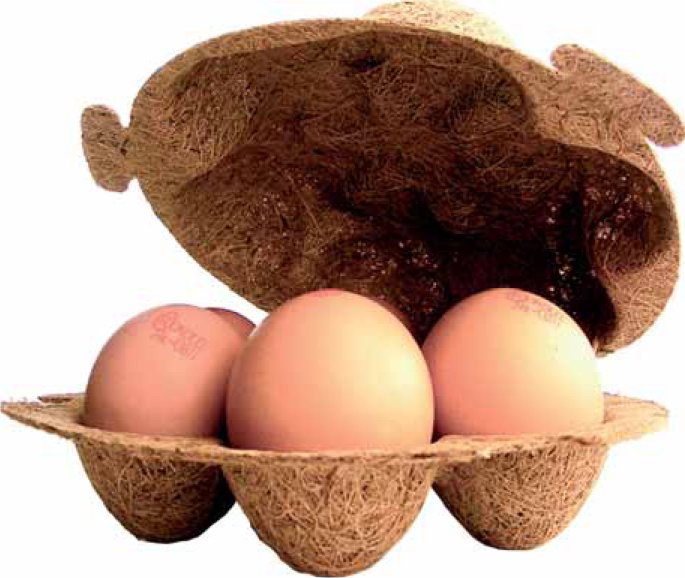Coconut Fibres (Cocod nucifera)
Have you ever seen an old armchair with seams that have come loose to reveal the rough, fibrous brown hair construction inside? If this sounds familiar, then either rubberized hair or coconut coir may have been the material used inside. Coconut, like bamboo, is becoming one of the beacons for the ‘green’ materials movement. Unlike bamboo and other plant-based materials, which are derived from the tree or trunk, it is not the palm tree itself but the fruit that is driving the area of greatest innovation. It’s easy to see why; if you break open a fresh coconut you will see how well protected this seed is by the various layers that surround it, from the tough skin to the matted layer of coir that acts as a primitive bumper to stop the husk breaking when it falls from the tree. This multipurpose fruit has helped earn the palm tree a reputation as one of the most productive trees in the world, exploited mainly for its fruit but also for its trunk for producing timber, food and other products.
The hard husk of the coconut has been used in applications that exploit its hardness and durability; in some cases, it has been used to make small tiles for hard-wearing flooring. Perhaps more well known is the tangled, matted coir with its coarse, stiff, springy structure, that when dried out has been used in all manner of cushioning applications. According to Enkev, a supplier of fibres, coconut products have also been used to form packaging for eggs, perfume and luxury gifts.
Image: Cocolok® packaging by Enkev

Key features
•Compostable
•Ventilates well due to its open structure
•Good sound insulation
•Good strength
•Very tough
•Waterproof, although fibres swell in water
•Relatively stiff and good in tension
Sources
India and Sri Lanka are the world’s largest growers and exporters of coconut.
Cost
As an agricultural waste product from the coconut oil industry it is not difficult to source. It can be used as cheaper alternative to building materials but, depending on application, prices vary.
Sustainability issues
Unlike many fruit-bearing trees, palm trees produce fruit at varying degrees of ripeness, providing 50 to 100 fruits per year.
Production
In order to get the most use out of the fibres they are washed, dried, curled by a spinning process and then fixed by steaming. They can then be processed in different ways including needling, which helps bind the fibres together. The fibres are also often combined with latex rubber to form sheets of various thicknesses that can be press-formed into 3D forms or die-cut into shapes.
This dense construction is based on a type of biomimicry, where the cushioning that the fibres give the coconut is applied to shoes, mattresses and upholstery. The fibres are also often covered with natural latex, which adds elasticity, for uses such as shoe soles and cushioning for upholstery. Other applications include packaging, ropes and scouring pads, and it is processed for food and oil. Also used as a natural-fibre reinforcement for concrete, insulation, doormats and brushes. Its swelling in water results in use in boats for plugging spaces between planks.
| + | – |
|
–Good ventilation and sound insulation –Strong and tough –Extremely sustainable and compostable |
–Coconut-fibres are flammable, so must be treated with a fire retardant for certain applications |
